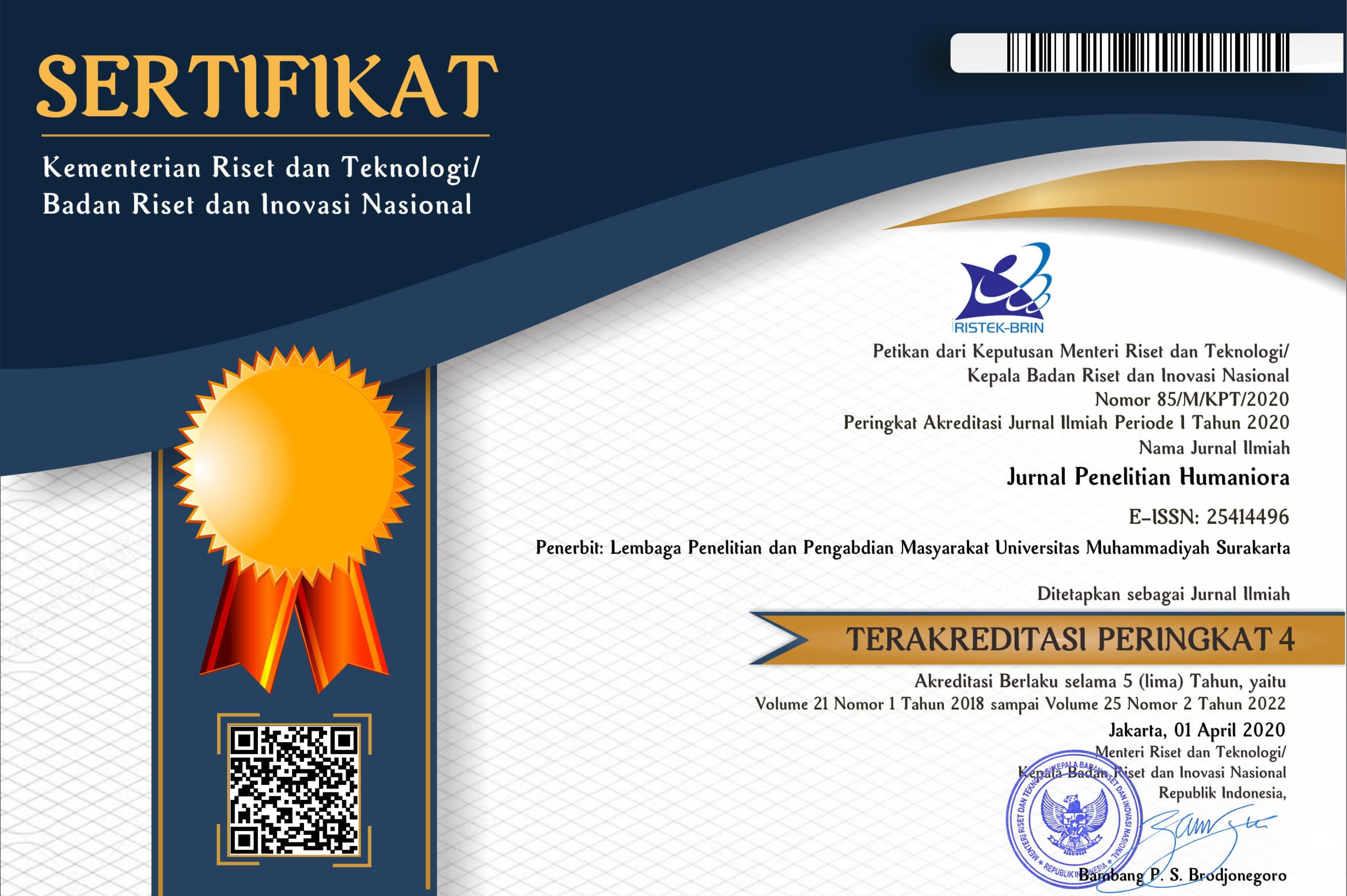PRAGMATICS STUDY ON DEIXIS IN THE JAKARTA POST EDITORIAL
Wahyudi .(1*)(1) Universitas Muhammadiyah Surakarta
(*) Corresponding Author
Abstract
The purposes of this research are to describe the types and references of the deitic words used in the Jakarta Post editorial. The central topics of pragmatics, this study is limited on applying deixis on the Jakarta Post for July 2012 editorial. Method of data collection that is used by researcher is documentation method. There are five types of the deitic words. The first is personal diexis which includes the followings: (1) the first person I refers to a speaker inclusion (+S) and speaker exclusion (S). We refers to an including the speaker but excluding the hearer (s) (+S, A) (Expressive use), include both speaker or writer and hearer (s) or reader(s) (+S,+A) (Integrative use) and an in cluding the speaker, listeners and some assuming hearer (s) or reader (s) (+S,(assuming) + A) (assuming use); (2) The second person, You refers to addressee inclusion (+A) and exclusion (A); (3) The third person, speaker and addressee exclusion (S,A). He or she refers to male or female person, unknown gender and a male or female person’s occupation. They refers to an indefinite (singular) person, group of people or things and non persons. The second type is temporal deixis which can be categorized into the follow ings: (1) time relation (pre, present, post events), (2) time period (calendrical and non caldrical), and (3) the moment of utterance (coding and receiving time). The third type is spatial Deixis which includes proximal expression (here) and distal expressions (there). The forth type is discourse dexis which includes this and that, refering to large amount of the discourse that are located in the discourse itself. The fifth type is social deixis. The relational variety is the most important deixis which involes four axes as speaker and referent e.g. referent honorifics, speaker and addressee, addressee honorifics, speaker and bystander. There are two references of the deitic words are used. They are referential devices that can create cohesion (anaphoric, cataphoric, and exophoric) and type of references (reference personal, demonstrative and comparative).
Keywords
Full Text:
PDFReferences
Duyile, D. 2005. Writing For the Media – A Manual for African Journalist., Lagos: Gong Communication.
Halliday, Michael. A. K.; Hasan, R. 1975. Cohesion in English. London: Longman.
Hoffman, M. 2007. Academic’s Dictionary of Mass Communication. New Delhi: Academic.
Hoffman, Th.R. 1993. Realms of Menaing: An Introduction to Semantic: London and New York: Longman.
Holmes, Janet. 1992. An Introduction to Sociolinguistics, London: Longman Group Limited.
Huang,Yan. 2007. Pragmatics, New York: Oxford University Press.
Kredler ,Charles W. 1998. Introducing English Semantics, New York. Routledge.
Levinson, Stephen.C. 1983. Pragmatics, New York: Cambridge University Press.
Levinson, Stephen. C. 2004. Deixis and Pragmatics, In L. R. Horn & G. Ward (Eds.), Handbook of Pragmatics. MA: Blackwell.
Okoro, N. and B. Agbo. 2003. Writing For the Media Society. Nsukka: Prize Publishers.
Renkema, Jan. 1993. Discourse Studies: An Introductory Textbook. Amsterdam: John Benjamin Publishing Company
Article Metrics
Abstract view(s): 2139 time(s)PDF: 2221 time(s)
Refbacks
- There are currently no refbacks.











